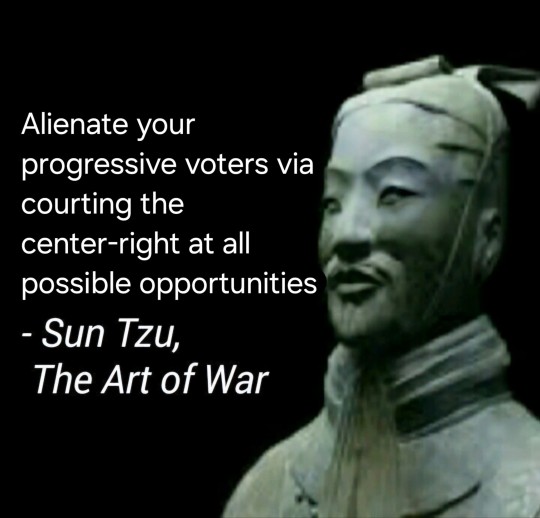Text
chronic pain diagnoses are all like yeah we don't know what this is or why it happens. we also don't know how to treat it. good luck out there soldier
34K notes
·
View notes
Text
29K notes
·
View notes
Text
Every week I put on RWBY (a show I do not like) for a Discord. 13 episodes deep into Volume 8 I decided to change the intro to inspire some morale in the five other people who are also miserable.
105 notes
·
View notes
Text
Castle Super Beast episode #320
3K notes
·
View notes
Text
You will misunderstand the economic history of white supremacy in America if you’re under the impression that convict labor (the “except as punishment for a crime” bit of the 13th Amendment) was how the plantation economy of the South continued after the official abolition of slavery. It mainly wasn’t. Convict labor was always only a relatively small sector of the Southern economy.
The vast majority of freed slaves became sharecroppers and tenant farmers on white-owned land. This was the real basis of the continuation of the slave-based Southern agrarian economy. And though many of the most egregious elements of slavery were now mostly gone (the whip, the overseers, the legal inability to leave), the basic slave-plantation economy was still intact as these black farm laborers now basically worked for the same “wages” as they had as slaves. Landowners would sell a few basic living essentials like food, clothing, and heating oil to the laborers on credit, and at harvest time, the sharecroppers’ or tenant farmers’ “earnings” from their crop would be used to pay off their debt to the landowner, usually leaving them at zero, or even still in the red, indebted to the landowner. From a financial standpoint, this was hardly any different than slaves working and receiving zero wages besides those same basic living essentials from the slave master.
Forced convict labor existed in all of this, and was used to keep many black people involved in more obvious slavery (complete with the chains, the overseers, and even the whip), but the convict-leasing system and the state-run plantations run by prison labor did not constitute the majority of the Southern economy, neither in terms of the percentage of the population involved nor in economic output.
To this day, prison labor in the US only constitutes a small fraction of the economy, and is not in any way profitable. The companies that use prison labor are able to profit because they don’t have to pay any of the living costs of the prisoners, nor the costs of incarcerating them, as the state pays for all that. The amount of money the state has to spend incarcerating people dwarfs the amount of revenue there is to be gained from exploiting prison labor. It is generally a net loss for the overall economy. Even in cases where the state saves money by using cheap prison labor to replace expensive free labor (like California’s firefighters), this is simply them attempting to recoup some of the cost they spend incarcerating those workers in the first place. Whether the state uses prisoners as firefighters or not, it costs them the same amount of money to lock those people up, it’s a sunk cost. So they figure they might as well try to save some money on their fire-fighting budget by employing prisoners at $2 an hour instead of free labor at $40/hr.
Prison labor cannot in any way be described as the basis of the US economy, and it cannot grow to become one either. It is unproductive. Incarceration loses more revenue than it generates. The prison-industrial complex is a parasitic tumor on the economy. It does not constitute the economic logic of white supremacy. The US carceral system needs to be understood as an apparatus of state terror, not of economic production. Its purpose is to discipline and intimidate, not to produce. Its purpose in the structure of white supremacy in America is not for the exploitation of black labor. If that were its purpose, it does so incredibly inefficiently, spending more money than it earns. Its purpose in the structure of white supremacy is for terrorizing and disciplining the black population, breaking urban black political power, and strengthening rural political representation.
8K notes
·
View notes
Text
"I know chatgpt is bad but you just don't really have any choice" you literally do. Don't use it. Have some moral backbone.
146K notes
·
View notes
Text

you just returned from another traumatizing world-ending reality and you promised you had to participate in your servant's wacky ass event
821 notes
·
View notes
Text
🤗 i dont like this emoji. this is not a hug to me. this is someone doing condescending jazz hands in my general direction when i am in need of affection. not comforting.
🫂 i love this emoji. this is a hug. we are hugging and its nice. and as a special bonus they appear to be my old friends from the msn messenger logo? very comforting.
17K notes
·
View notes
Video
Lupin III: The Fuma Conspiracy | Director: Masayuki Ōzeki | Studio: TMS | Japan, 1987
3K notes
·
View notes
Text
does anyone have that comic about soulslike bosses where it's
"amorphous mass of tentacles: okay, I got this
some guy staring into the sunset just called The Captain: oh fuck"
13K notes
·
View notes
Text
robotgirl safewording after its girlfriend pulls out a flash drive with a windows 11 installer
7K notes
·
View notes

















